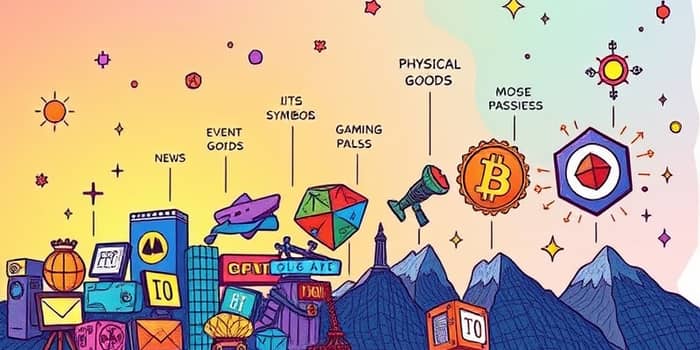
Over the past year, the NFT market has undergone a dramatic transformation. What was once a playground for speculative trading and profile picture mania has given way to sober reflection and a renewed focus on practical applications. Investors, creators, and enthusiasts are recalibrating expectations in light of steep sales declines and evolving market dynamics. This article explores the forces behind the downturn and charts a course toward sustainable, real-world use cases that promise lasting value.
The era of speculative digital art and collectibles soared to dizzying heights in 2021–2022, only to face a dramatic volatility and decline in subsequent years. Trading volumes plunged by over 60% between 2023 and 2024, culminating in 2024 as the worst year since 2020 with just $13.7 billion exchanged globally. The first quarter of 2025 continued the slide, witnessing a 63% year-on-year drop from $4.1 billion to $1.5 billion.
March 2025 was particularly brutal, with sales collapsing by 76% compared to the previous year, falling from $1.6 billion to $373 million. The art segment suffered even more, with volumes plummeting by 93% from its 2021 peak. While a late rebound pushed monthly sales back to $430 million by May, experts caution that a return to prior exuberance is unlikely.
The sudden crash left many artists and investors reeling, with high-profile flops fueling skepticism. Once-architects of the digital renaissance found themselves recalibrating strategies, and new entrants hesitated. This collective unease played out across social media, where discordant narratives of lost fortunes and unrealized dreams shadowed the narrative of promise.
Following the bust of high-profile projects like Bored Ape Yacht Club and CryptoPunks, the NFT market has stabilized at a far more modest scale. Global user numbers in 2025 are projected at around 11.6 million, virtually unchanged from 11.58 million in 2024. This plateau underscores that the frenzy of the past was largely speculative rather than reflective of broad mainstream adoption.
Financial forecasts for 2025 paint a picture of cautious optimism rather than meteoric growth:
Despite plateauing user numbers, engagement levels vary widely across regions and demographics. Emerging markets in Asia and Africa show budding interest, often driven by gaming and social platforms that integrate tokenized items. This uneven distribution suggests untapped potential outside traditional crypto hubs.
Several converging factors have driven the market downturn, prompting stakeholders to reassess risk and opportunity:
In the wake of declining speculation, a promising trend has emerged: a pivot to real-world utility and innovative use cases that anchor NFTs in tangible value. Forward-thinking projects are exploring models that combine digital tokens with everyday experiences, goods, and services.
Major brands and startup innovators alike are experimenting with hybrid models that merge the digital and physical worlds. For instance, Doodles’ partnership with a global fast-food chain extended token access to real-world promotions, illustrating how brand collaborations can amplify reach and trust. These early successes demonstrate that utility-focused NFTs can thrive when they deliver clear, tangible benefits.
The regulatory landscape remains a critical factor shaping the market’s evolution. The US SEC’s closure of its OpenSea investigation without charges offered a temporary sigh of relief, but clearer standards are still forthcoming. Market participants are watching closely for guidance on how NFTs will be treated under securities law and taxation rules.
Analysts anticipate that the next growth phase will be driven not by speculative fervor but by sustained value creation. Success stories like Pudgy Penguins and Doodles—collections that posted revenue increases in Q1 2025—underscore that community engagement and strategic partnerships can temper volatility. However, broad recovery will likely depend on wider crypto market cycles and continued innovation in use cases.
Looking ahead, key variables will include the outcome of upcoming legislative frameworks and international coordination. As governments define standards for digital assets, global interoperability and compliance will become indispensable. Projects that proactively address legal and tax considerations will likely gain a competitive edge in this more structured environment.
For creators: prioritize projects with clear real-world value propositions and build robust communities around utility rather than hype. Consider collaborations with established brands, physical goods, or event experiences to bolster perceived worth.
For investors: conduct thorough due diligence. Assess the token’s utility roadmap, existing partnerships, and governance structure. Beware of collections lacking transparent utility plans or sustainable revenue models. Diversify exposure by balancing collectible projects with utility-driven initiatives, such as gaming tokens or tokenized real assets.
For enthusiasts: stay informed by following reputable news sources, developer updates, and regulatory announcements. Participate in forums and governance systems to help shape the future of NFT standards and protocols. Your engagement can drive innovation and ensure projects serve genuine user needs.
The NFT market’s shift from headline-grabbing speculation to practical applications represents a pivotal moment in its maturation. While trading volumes may never return to the wild highs of 2021 and 2022, the industry is poised to deliver sustainable long-term value through tangible use cases. By embracing utility, fostering community, and navigating regulatory frameworks with care, creators, investors, and users can help shape a more resilient and impactful digital asset ecosystem.
Ultimately, this new era of NFTs is not defined by the grandeur of price tags, but by the depth of real-world connections and experiences they enable. The future belongs to those who innovate with purpose and align technology with genuine human needs. Now is the time to move beyond speculation and unlock the true potential of digital ownership.
References













